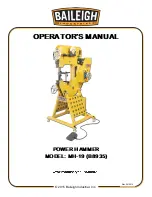
3-22
ATE-DMG 020613
mode will be, so the unit is never uncontrolled, response is quick and no transients are possible.
Recommended programming techniques are:
1. Minimize programmed mode (voltage or current) changes. Unless absolutely required by the
test parameters, allow the power supply to automatically switch modes as determined by the
load. This will improve response time and reduce undesirable transients. For those power
supplies that employ relays (Kepco's MBT with “R” option, MAT and MST) this will also
increase the life of the relay.
2. Once the mode (voltage or current) is programmed, program the active parameter to zero
and the complementary limit parameter to the maximum anticipated for application. Then
program only the active parameter. The active parameter is the parameter that controls the
output, e.g., voltage controls the output in voltage mode.
3. Never program both the active and complementary limit parameter to zero. This can result in
long response times. Set the active parameter to zero and the complementary limit parame-
ter to a minimum, e.g., 10% of maximum, to ensure that the active mode is defined.
3.7
SCPI PROGRAMMING
SCPI (Standard Commands for Programmable Instruments) is a programming language con-
forming to the protocols and standards established by IEEE 488.2 (reference document
ANSI/IEEE Std 488.2, IEEE Standard Codes, Formats, Protocols, and Common Commands
). SCPI
commands are sent to the ATE-DMG Power Supply as ASCII output strings within the selected
programming language (PASCAL, BASIC, etc.) in accordance with the manufacturer’s require-
ments for the particular GPIB controller card used.
Different programming languages (e.g., BASIC, C, PASCAL, etc.) have different ways of repre-
senting data that is to be put on the IEEE 488 bus. It is up to the programmer to determine how
to output the character sequence required for the programming language used. Address infor-
mation (GPIB address) must be included before the command sequence. (See PAR.3.6.3 to
establish the ATE-DMG Power Supply GPIB address.)
3.7.1
SCPI MESSAGES
There are two kinds of SCPI messages: program messages from controller to power supply,
and response messages from the power supply to the controller. Program messages consist of
one or more properly formatted commands/queries and instruct the power supply to perform an
action; the controller may send a program message at any time. Response messages consist of
formatted data; the data can contain information regarding operating parameters, power supply
state, status, or error conditions.
3.7.2
COMMON COMMANDS/QUERIES
Common commands and queries are defined by the IEEE 488.2 standard to perform overall
power supply functions (such as identification, status, or synchronization) unrelated to specific
power supply operation (such as setting voltage/current). Common commands and queries are
preceded by an asterisk (*) and are defined and explained in Appendix A (see Table 4-4). Refer
also to syntax considerations (PARs 3.4.3 through 3.4.6).
3.7.3
SCPI SUBSYSTEM COMMAND/QUERY STRUCTURE
Subsystem commands/queries are related to specific power supply functions (such as setting
output voltage, current limit, etc.) Figure 3-8 is a tree diagram illustrating the structure of SCPI
Summary of Contents for ATE 100-10DMG
Page 2: ......
Page 6: ......
Page 14: ......
Page 15: ...ATE DMG020613 ix FIGURE 1 1 ATE DMG SERIES PROGRAMMABLE POWER SUPPLY...
Page 16: ...ix Blank x ATE DMG020613...
Page 24: ...1 8 ATE DMG OPER 020613 FIGURE 1 2 MECHANICAL OUTLINE DRAWING SHEET 2 OF 2...
Page 26: ...2 2 ATE DMG 020613 FIGURE 2 1 ATE DMG FULL RACK SERIES FRONT PANEL...
Page 34: ......
Page 74: ......
Page 98: ......
















































